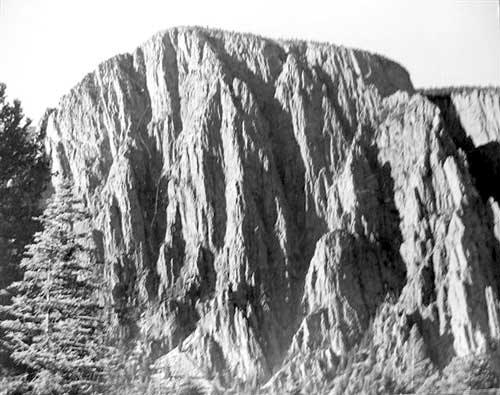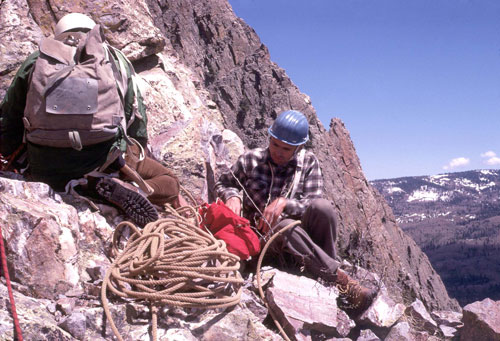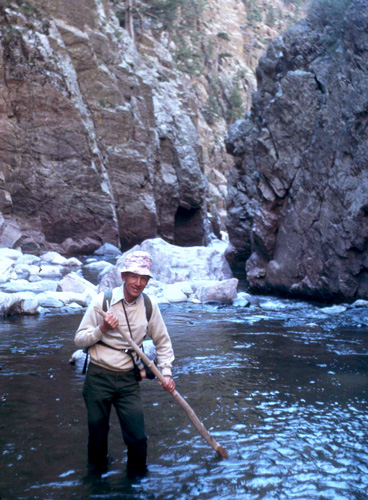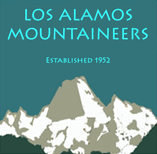|
5.
Adventure and Exploration at the Brazos Cliffs
LAM History Index |
Go
to Previous Topic |
Go to Next Topic The early history of the Mountaineers
is closely linked to the era of discovery, exploration, adventure, and
misadventure in the Brazos Cliffs near Tierra Amarilla in northern New
Mexico. The cliff escarpment is about 3000 feet high and extends for
roughly 2 miles on the west side of the Brazos Box canyon and about 1
mile on the east side. The climbing routes on the main walls are roughly
2000 feet high and range in length from 10 to 17 pitches. So there are
literally several square miles of rock to explore, providing nearly
endless climbing possibilities. Click
here to
read about current Brazos Cliffs
access issues.

Fig.
1. The Main Brazos Cliffs as seen from the South. The most popular
route, Easy Ridge, ascends the ridge just right of the highest point on
the cliffs and just right of the large dihedral called the Bowling
Alley. The Great Couloir Direct climb is just left of the high point.
George and Ginny Bell
were the first to explore the Brazos Cliffs. Ginny Bell moved to Los
Alamos in 1950 and George arrived in 1952, where he was a driving force
in the Theoretical Physics Division at LANL for almost 50 years. George
was also an avid mountaineer and outdoorsman. He participated in 4
expeditions to the Peruvian Andes in the 1950's, including first ascents
of two of Peru's highest and most difficult peaks. He was a member of
the 1953 American expedition to K-2 (described in a later section on
"Memorable Programs." George and Ginny Bell met at a Mountaineers'
meeting just before he left to join the K-2 expedition. Ginny Bell had
done ballet and acrobatics when she was at the University of Wisconsin.
She recalls that she had no fear of heights on rock and that she found
climbing easy!
By the fall of 1954, George Bell and other club members had worked out
routes up the first half of the Great Couloir and Easy Ridge. That same
fall, George Bell and Don Monk then completed the first full ascent of
the Great Couloir, alternating the leading. In June 1955, George Bell,
Virginia Lotz, Don Monk, and Keith Brueckner made the first ascent of
"Easy Ridge." (Note added by Skip Bell -- Virginia Lotz is the maiden
name of Ginny Bell.) Don Monk described the last few pitches of Easy
Ridge, from what is now called the Pedestal Pitch to the last roped
pitch: "Bell led first near the crest of the ridge, overlooking the
green face. Then a traverse to the right and a climb up a crack led to a
small ledge around the corner of the immediate face of the ridge. Three
pitons were used on this pitch to reach the airy ledge, which overlooked
the neighboring couloir hundreds of feet below. A large step was
required to get up and around the next corner to a more comfortable
belay spot. The next task confronting the party was to climb a
triangular-shaped face, its left hand formed by the "Easy Ridge," its
right side by a subsidiary ridge, and its base by a precipitous change
of gradient in a plunge to the floor of the couloir. The group decided
on a route well to the right of the "Easy Ridge," a system of chimneys
and cracks leading up just to the right of the apex of the triangle. The
climbing, although hard, seemed easier, since chimney climbing usually
decreases the appearance of exposure. Four pitons were used on several
leads to debouch the foursome out of the triangle and into a virtual
meadow -- grass, trees, low angle, still 600 vertical feet from the
summit. . . . Time 8 hours; pitons 14, one for a handhold (used in the
triangular face); class 5." Some of the pitons used in the more
difficult sections were left in place as residents, and were used for
many years by later climbing parties.

Fig.
2. George Bell on the first ascent of
Masherbrum in 1960 (Nicholas
Clinch photo).
George Bell prepared an article on the
area for the Colorado Mountain Club's Trail and Timberline publication.
The article, dated March 1972, is still the only published guide to the
Brazos. George provided an excellent description of the cliffs and
marked the routes known at that time, including the names and dates of
the first ascent parties. The article includes pictures of the Main
Cliffs, the Brazos Box area, and the Wedge. George Bell began his
article with the following well-phrased description of the Brazos:
"Nowadays, when a climber stumbles onto a particularly fine but unknown
area, he is tempted to talk little about it except to a few chosen
friends. Better to at least get in some of the choicest routes before
mentioning it in climbing journals and before encouraging the hordes of
other climbers to our cliffs. So, for the last twenty years, we in Los
Alamos have been enjoying our favorite Brazos Cliffs in Northern New
Mexico, not exactly secretly, since who can keep two-thousand foot
cliffs secret when they are plainly visible from a U.S. highway eight
miles away, but at least quietly . . ."
"For those who wish to read no farther the lesson is this: though the
cliffs look nice enough from a distance they have many bad
characteristics and consequently should be avoided by the inexperienced.
For one thing, the rock is a particularly hard quartzite which will
defeat all attempts to drill bolt holes; while cracks abound, they will
frequently scratch or refuse to relinquish pitons; though good holds are
common, a few areas are water polished and the rock is exceedingly slick
when wet. In addition the cliffs are all on private land and some of the
landowners are ill disposed toward any trespassers at all, worst of all
those that are dirty, bearded, and jangling, and considered thereby to
offend the nose, the eye, and the ear. Finally, while some of the routes
are relatively easy to reach, others can be gained, if at all, only at
low water, by wading up the treacherous rapids and icy pools of the
Brazos River."
Don Liska came to Los Alamos in 1966 and climbed in the Brazos as late
as 2003, a 38-year period. He recalls that "My first climb with the
mountaineers occurred only 2 weeks after we arrived in Los Alamos in
June, 1966. We climbed Easy Ridge. Emily Willbanks and Ken Ewing were
there. We did overnights in those early days and slept out near the
Brazos Lodge. It was a pretty big deal, going to the Brazos in the 60's.
One could not buy gas in Los Alamos as the only station closed on
weekends. You could get a little gas from the police but you had to have
enough to reach Espanola. Sometimes people would run out on the way."
Don Liska, Dick Ingram, George Goedecke, and Paul Wholt did the first
ascent of the Great Couloir by the Direct Finish (17 pitches) later in
1966.
Len Margolin came to Los Alamos in 1969 and quickly became one of the
club's strongest climbers. He said that climbers like himself and Don
Liska "had the low-hanging fruit." They could do everything for the
first time and didn't have to worry about style, etc. Don said that "We
got so familiar with the Brazos we did all sorts of obscure 'firsts' and
tied all routes together with hair-raising traverses. We would bring
back the licorice-smelling plant on those cliffs and keep it in a jar at
home for weeks, always reminding us of 'unfinished work' at the Brazos.
On one juvenile stunt, Larry Dauelsberg, Ernie Anderson, and I dashed
out to the Brazos in June 1968 to do the 'Direct Start to Easy Ridge'
which added 5 pitches to the standard 10-pitch route and made Easy Ridge
one of the longer climbs on the face. The juvenile part was a rumor we
heard that some other local climber had his mind on that route. It shows
how determined LAMC climbers were in those days to do new things at the
Brazos. Several of us also did winter explorations of the Brazos cliffs
and tried dead-winter ascents. On one attempt on Easy Ridge we were
three pitches into the route when a ton of ice came down and chopped the
belay tree off at the five foot level. This made us stop and immediately
descend."
Don Liska recalls that "On the 1968 first ascent of Gothic Arches
Buttress we took four weeks to work out the route, returning to Los
Alamos between weekends. On the last weekend, near the top and climbing
by moonlight, I zippered out a string of direct aid pitons and was
caught on a 30' fall by my buddies. Gothic Arches was a high caliber
route in those days, rated 5.7 and 22 pitches. Why did we climb by
moonlight? Well, to have a comfortable bivouac at the top of course.
Instead we had an uncomfortable bivouac on the face. I should at least
have used hero loops and a swami belt. Seat harnesses were rare in those
days and individually wrapped out of 1" tubular webbing."
To elaborate on George Bell's description, Brazos rock is a sharp,
heavily fractured quartzite, which breaks the cliffs into a series of
fractured ridges and water-worn couloirs. The faces to the west of each
ridge tend to be smooth, steep, and heavily lichen-covered and are
therefore usually unclimbable. The ridges themselves, and the faces to
the east of them, tend to have good crack, corner, and face climbing
options. Most ridge and face pitches range in difficulty from 5.4 to
5.8. Indeed, it is hard to find climbable pitches at a higher level
because both the holds and the protection tend to disappear at the same
time.

Fig.
3. Mike Williams and Bill Frye on Easy Ridge during the 1969 climbing
school graduation climb,
showing a typical rubble-covered belay ledge (Bob Cowan photo, May
1969).
To reinforce George Bell's cautions,
despite the easy ratings climbing in the Brazos is a serious
mountaineering experience! Where the holds and the protection are
plentiful, the quartzite is often brittle and dangerously loose. Many
holds must be carefully tested before applying weight and many belay
ledges are loaded with piles of sharp loose rocks. Should a summer
thunderstorm come up, the danger from lightning is high. Even worse,
once the lichen-covered rock becomes wet, it becomes so slimy that it is
impossible to keep climbing upwards. Climbers must either wait until the
rock dries out or start a long series of dangerous rappels, exhausting
their lead racks to place anchors. Mario Schillaci remembers that about
half of all his Brazos trips involved rapping off in the rain. Lastly, route finding is a
never-ending challenge that requires constant attention to the lay of
the rock and the best climbing direction. Almost all of the Mountaineers
can look back and remember at least one time that they actually started
up the wrong route, not realizing it until it was too late to start
over! And once the top is reached, the descent gully provides more
route-finding, scree, and rock-rolling challenges for the tired climber.
Thus fear, loathing, and stomach-turning stress can become part of any
adventure climb in the Brazos!
For almost two decades, roughly half of all the Mountaineers' summer or
fall climbing trips had the Brazos as their destination. The climbing
season would begin with the climbing school, which gave everyone a
chance to get warmed up. After the graduation climb, the Mountaineers
would start going to the Brazos. During the summer, climbers went to the
Brazos almost every weekend, except at the peak of the rainy season when
the risk of getting caught in a thunderstorm was just too high. The
season usually ended with a trip to the Wedge in early October, when the
first snowflakes started to come down.
During these years the Mountaineers continued to put up new routes or
new variations on existing routes. Don Liska and Larry Campbell put up
Cat Burglar in 1971. Merle Wheeler, Carl Keller, Len Margolin, and
George Rinker did Resignation Ridge in August 1974, naming the climb in
"honor" of President Nixon, who had resigned earlier that week. Chris
Foster, Dave Barlow, Ralph Menikoff, and Norbert Ensslin put up the
15-pitch Relentless Ridge in September 1983, choosing this name because
it took 3 attempts with a bivouac on each attempt to finally reach the
top. The bivouac ledge was not so bad, however. It was called the
"Brazos Hilton" because it was 200 feet long, 50 feet wide, and covered
with thick lush grass. There is also a small overhang at the back to
keep out the rain.
Up through the 1980's, the period of most climbing activity in the
Brazos, roughly 45 routes or major route variations were named and
documented. In 1986 the club voted against assembling these into a
guidebook to help preserve the sense of wildness that is so unique to
these cliffs and to give future generations of climbers a chance to
re-discover the cliffs for themselves. However, climbers who want to go
to the Brazos can contact some of the senior members of the club to
obtain individual route descriptions or topos.
Given the serious rockfall, endurance, accident and liability issues
associated with climbing on these cliffs, it may be understandable that
the Brazos are now reverting back to wilderness. Over the past two
decades the cliffs have seen less and less use. While climbing Easy
Ridge in the late 1990's, Norbert Ensslin broke the last resident ring
piton that George Bell had placed in the 1950's. It was so rusty that it
broke off with a touch of the fingers. With the advent of sport climbing
and the availability of many fine new climbing areas with better quality
rock within several hours' drive of Los Alamos, few people are still
interested in the level of commitment and risk required to climb in the
Brazos. Jim Straight remembers that he may have led the last big club
trip to the Brazos in the mid-1980's. The trip had about 40 participants
and was just too crowded for anyone to want to lead it. With some of the
climbers inevitably getting lost or climbing too slowly and then getting
stuck on top in the dark, club trips to the Brazos were always a strain
on some of the participants as well as on the trip leader.
For many years the landowners' agents, Bob and Irene Hobson, asked all
climbers to register in a logbook at their cabin before starting up the
cliffs. This was a way of formally requesting permission to climb, which
in some years was granted only to members of the Mountaineers. It also
helped the Hobsons handle phone calls from anxious relatives if the
climbers did not return by dark (which happened fairly often). This era
has now come to an end: Bob Hobson passed away in 1988, and Irene Hobson
in 2005. At their requests, made before their deaths, Don Liska, Len
Margolin, and Norbert Ensslin took their ashes to the top of the cliffs
and distributed them just above the prominent white spot that is visible
near what appears to be the top of the cliffs, as seen from the Hobson's
former cabin in the valley below. The Hobson's registration system is no
longer in use, and there are now only a few climbers per year that come
to the Brazos. At this point in time (2006), climbers who want to seek
permission to climb the cliffs should contact Corkin's Lodge. However,
it is not clear if permission would be granted.

Fig.
4. Roland Pettit, club member and author of a Jemez hiking guidebook, wading in the Brazos Box (Bob Cowan photo, September 1976).
Climbs on the Brazos Wedge or in the
Brazos Box can also be approached from the highway between Tierra
Amarilla and Tres Piedras, or from a rough jeep road on the south side
of the Brazos River. Because of the longer approaches, Brazos Wedge
climbs were commonly done near the end of September or in early October
to enjoy the fall colors and avoid afternoon thunderstorms.
Interestingly, Lou Horak reports that the Brazos Box is now considered
an expert kayak run, when the water is up. (A note from Jan Iversen: her
daughter Megan is the youngest person to climb the Brazos cliffs -- she
did the West Ridge of the Wedge while still in her mother's womb when
Jan Iversen and Paul Horak climbed the route around 1982.)
For those who wish to approach the Brazos Wedge via the jeep road, it is
advisable to check first with the Mundy family of Chama, who own most of
the land in this area. (The Mundys sold some land to George Bell many
years ago, and the Bell family maintained a small cabin for summer
visits.) An anecdote that provides an example of access issues in this
area was provided by Don Liska: "In the 1980's Mark Zander and I decided
to go into the Brazos Box and climb Razor Ridge together. We were
audacious and fit in those days, so we drove Mark's old pickup through
the Tierra Amarilla community fields and parked at the usual spot, on
Emmet Mundy's property, in the boondocks above the entrance to the Box.
We climbed down to the river and waded upstream to the start of the
climb. Despite its middle 5th class rating we scrambled up the route unroped gripping the edge of the razor and yelling in joy. We finally
sobered and condescended to rope up for the final pitch mainly because
we felt foolish carrying the rope and not using it all that way."
"We topped out and then descended the gully back into the Box and
returned to the car. We found a note on the windshield that read 'You
are trespassing. Your time will come.' We had no idea who left the note
but its threatening vein truly scared us. We gently lifted the hood and
checked all around for a bomb. Finding nothing we headed back out along
the old stagecoach road. Crossing back across the community field we
spotted a horseman galloping towards us at full speed. He cut us off and
he looked really intimidating with his six-gun and on a huge grey
heaving horse. It was a truly wild west stickup scene. It was Emmet
Mundy himself and he was mad as hell. He accused us of poaching. We
tried to argue as he had gotten us a bit mad too. Finally we revealed we
were climbers and had just done a route in the Box. When he heard that,
he right away turned to smiles and friendly handshakes. Do you know Dr.
Bell?' he asked. Of course we knew George well and then the conversation
became very mellow and friendly. 'Come back anytime,' said Emmet as we
drove off for home."
"It turned out that Emmet had seen an old NRA sticker on the rear window
of the camper top on Mark's old pickup - a sticker that came with the
used vehicle. Emmet thereby assumed we were out there either plinking or
poaching. However, since we were merely climbers (whom he admired as
somewhat crazy 'great guys' like his friend George Bell) he forgave all
and apologized for the mistaken identity. So Mark and I not only proved
him to be right with our crazy ropeless climb of Razor Ridge, but we
also won a real cowboy friend. We never saw Emmet again."
LAM History Index |
Go
to Previous Topic |
Go to Next Topic
.
|




